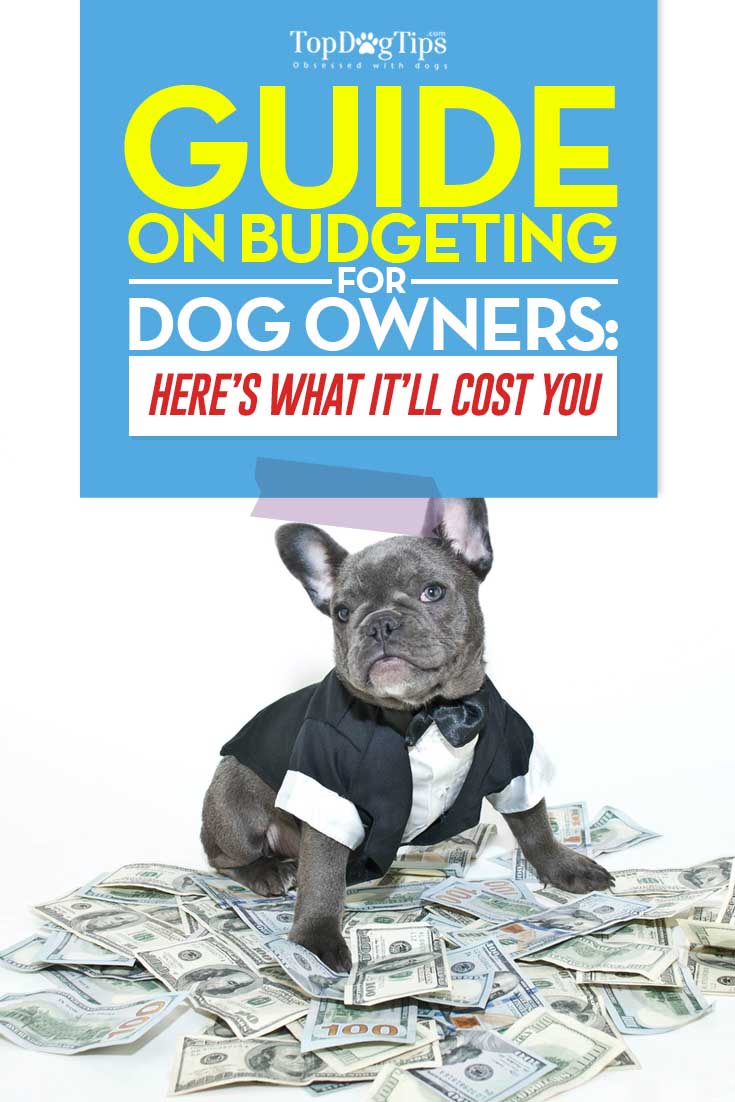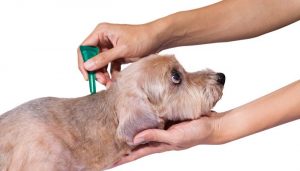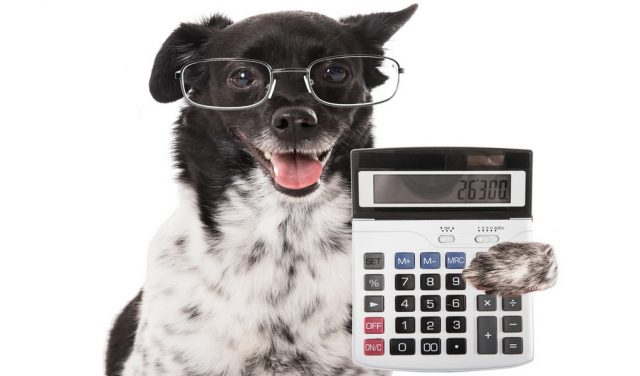
Table of Contents
You have decided to take the big step to becoming a dog owner.
Dogs live long lives, so you are committing for at least 10 years to be responsible for all your furry friend’s needs.
But how much does a dog cost?
In the US, it's been calculated that a dog can end up costing anywhere from $22,000 to close to $90,000 during its lifespan, according to Forbes.
That's a lot of additional income needed to support another family member.
Before you decide on adopting a dog, you need to make a budget to know if you are up to the financial responsibility of having a canine companion.
On top of the regular dog costs, you'll need a pet emergency fund for unexpected expenses and other variables.
There are plenty of things to account for. From dog food and dog supplies costs to vet bills and surprise dog care costs.
If you're not lucky to be among one of the top 1% earners in the US, you may need to have a separate pet budget to account for how much a dog costs you.
These 80+ tips on how to save on dog expenses may become especially helpful to avoid having your pet lead you into bankruptcy.
One of the common reasons pets are returned to shelters is because owners realize that they cannot afford the cost of owning a dog.
You need to be sure that you're capable of being financially responsible for a dog before adopting.
If you're unsure, it's best to do the math beforehand and find out how much a dog costs you specifically per month, per year, and over his whole lifespan.
So, how much does a dog cost exactly, and how can you make a budget before adopting one?
Let's dig in and do some preliminary calculations to help you decide whether it's something you can afford or not.
READ THIS: The Best Dog Food for the Money – 17 Brands Worth Their Price
How Much Does a Dog Cost?
Budgeting Guide for Dog Owners
 Dog Breed Costs: $50-$2000 First Year
Dog Breed Costs: $50-$2000 First Year
Before you choose your dog, you need to research the breed.
Some dog breeds cost more than others to purchase from the get-go.
Other breeds are not as inherently healthy and, therefore may end up costing a lot in veterinarian bills.
Or they may require a lot of grooming and general maintenance, meaning that you'll spend extra money on dog grooming supplies and other pet products.
Here are some first budget-related factors you want to consider before adopting a dog:
Do you want to pay for a certified purebred dog?
Some breeds are more expensive than others because of how rare or exotic their breed is. Moreover, paying for a purebred will be more costly than a mutt.
So make sure you don’t have a taste for purebred dogs if you have a “mutt budget.”
Getting a dog from a reputable breeder will reduce the chances of genetic health risks.
As was discussed on our podcast, inbreeding causes risks for genetic illness in dogs.
Those may be blindness, deafness, bone problems, digestion problems, and behavioral issues.
Ensure that if you get a dog from a breeder, they have references and certifications.
“Puppy mills” produce animals that are already sick due to unhygienic conditions, which will ultimately cost you a lot of extra in vet bills.
Have you researched the desired breed to check for general healthiness?
Some breeds have had lesser inbreeding. Some are also just genetically more hearty.
The breed of dog that you choose will be the largest factor in overall cost.
So, if it worries you how much a dog costs, you better do enough research on the type of dog you're adopting and know how healthy he's going to be.
Don't forget about first-time dog supplies. Once you adopt a puppy or an adult dog, he'll need dog food, dog toys, and some essentials like leashes, collars, bowls, and so forth.
You don't have to splurge on more expensive items that aren't vital, but some of these you (and your dog) cannot do without, so make sure you account for that (more on how much these costs are below in the article).
Here's a great chart on pet care costs that gives you some general ideas on how much a dog costs.
For more in-depth details, keep reading.
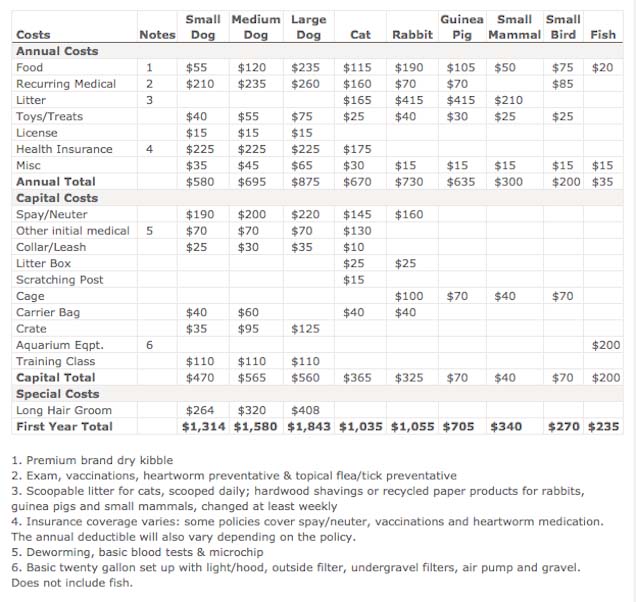
Vet Costs: $200-$400 Annually
Like us, animals get sick, and we can do nothing about it.
Your pet will also need vet care many times throughout its lifetime; therefore, you must consider vet costs when calculating how much a dog costs and creating your budget, at least for the first year.
The first thing you should budget for in terms of veterinarian costs is vaccinating your dog and having him neutered or spayed.
These are the two primary things you'll need to take care of right from the start (unless the shelter you've adopted from has done that for you).
I recommend you call your local vet before you adopt a puppy and ask how much a dog costs in terms of bills, specifically in their clinic, and what you should plan for.
All prices differ, so your local one will be able to provide you with the most accurate dollar figure you can get.
Here's a chart that will give you just an idea of how much you are looking to spend:
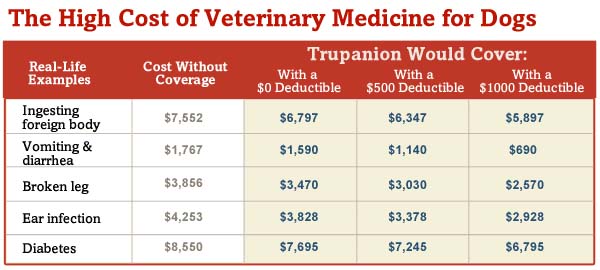
A few things you need to consider:
How big of a dog are you getting?
Medicine amounts, vaccinations, and anesthesia all go by weight.
The bigger your dog, the more these things will cost.
Large dogs generally cost more in other departments as well: more dog food, and large dog beds (more expensive), and they are often more prone to many health issues with age.
This can be anywhere from $100 to $500-$700, depending on how much you want to splurge on your large pooch.
You better have a steady income. Even after the initial first year of vaccinations, your dog will need yearly rabies.
Some vaccinations even need booster shots every few years.
That's on top of regular vet checkups and assuming nothing goes wrong. That's about $200-$300 a year.
Dogs get sick just like people. They can get bacterial and viral infections, often one of the most costly to treat.
So consider if you're going to be able to afford another $50 to $200 a year for unexpected vet expenses.
Generally, for vet bills alone (excluding unexpected expenses and major surgeries or whatnot), you're looking at spending around $200-$400 a year at minimum, at least in the first year.
In the following years, assuming nothing goes wrong, it may be around $100-$200 annually for general vet stuff.
CHEAPEST BREEDS: 25 Most Affordable Low-Cost Dog Breeds
Parasite Prevention Costs: $120-$600 Annually
Dogs' most famous problem is fleas. Then, you also have intestinal worms, heartworms, ear mites, and other parasites that continuously attack our canines.
Flea and parasite prevention is one of the key expenses to put on your budget before you adopt a dog.
Remember that it's the prevention and not treatment that you should focus on.
Preventing potential diseases in dogs will cost you a lot less money than treating them afterward and also keep your dog healthier in general.
You need to budget for monthly parasite prevention and calculate for these flea products, canine medicine, and some all-in-one parasite treatments.
Talking to your vet is one way to go, but doing online research usually can give you a good idea of how much a dog costs in terms of flea and tick treatments.
Here are some things to keep in mind:
Will your dog spend lots of time outdoors, or is he going to be home at all times?
A lot of this will depend on the type of dog breed you choose and how much exercise and being outdoors that specific dog requires.
Naturally, the more time your dog spends outside, the higher the chance of him coming into contact with parasites.
How big is your dog? Like with other medications and treatments for dogs, the cost of flea and worm prevention will slightly depend on the size of your dog.
It's not as big of a factor, but a larger quantity is needed for a larger dog when using drops, for example.
Should you use the cheapest method?
According to an NY Times article, it's been shown that fleas develop immunity to certain poisons.
Therefore, not only is it true that the cheapest flea collar or topical flea application may not kill your fleas, but you may have to rotate the type of flea treatment you're using.
It's like you'll regularly need to upgrade to a different brand and a more expensive product every few years.
As you can see, once again, a lot of this comes down to picking the right dog breed since all of them will have different costs.
If you do enough research beforehand, you can save yourself a lot of money in the long run.
RELATED: 10 Worst Dog Breeds for First-Time Owners
Dog Food Costs: $100-$255 Annually
Similar to many other canine-related health issues, some dog breeds are more prone to digestive issues, and others are more hearty.
Hearty dogs may be able to eat some of the cheapest dog food brands out there and not care, and pet owners of those dogs can consider themselves lucky.
However, certain dog breeds will be more picky about their dog foods.
Your canine may have predisposed digestive problems and require dog food that's specifically formulated for dogs with sensitive stomachs.
These brands may be slightly more expensive (at least more than the cheapest dog food brands), or you may need to start cooking homemade dog food for your pooch, which can also turn out to be costly.
On top of that, you may want to consider giving your dog essential vitamins and supplements.
You may think about buying dog food that has been fortified with those vitamins as well as probiotics for dogs.
This ensures a healthier dog, which eventually leads to lower vet bills.
Again, that's some of the math you need to do when making preliminary calculations on how much a dog costs.
Prevention of health problems will always cost less in the long run than dealing with pet health issues; however, it's always possible to go overboard with feeding your pooch too many vitamins, expensive dog foods, and other things that are completely unnecessary and a waste of money.
Consider some of the below tips on shopping for dog food (and other dog products) that will save you money.
READ THIS: 25 Clever Tips on Shopping for Dog Food on a Tight Budget
In the meantime, here are a few things to take into consideration:
What's the size of your dog? This is one of the easiest things to see and consider.
Larger breeds eat more than smaller breeds. They are also very prone to musculoskeletal health issues, which means you'd be smart to give them certain dog supplements that fight canine arthritis, hip dysplasia, or other bone and joint-related problems.
How active is the dog? Dogs that are more active end up burning more calories; therefore, they have to be fed more to maintain a healthy weight.
Lazy dog breeds that lay around the house don’t burn many calories, so they may eat less than a small hyper dog, even if they are of medium size.
You'll need to discuss this with a shelter so they can tell you the dog's behavior, too.
How healthy is the breed? You can do research online to find out the healthiness of the specific breed you are interested in.
If you don’t want to spend a lot of money on dog food, find a breed that is known for having no dog food allergies or sensitive digestive tracks and doesn't require any specific dog supplements for preventing diseases.
Dog Supplies Costs: $50-$200 Annually
There is almost no limit to the amount of money you can spend in the department of dog supplies.
Your local pet stores will have dog clothes, a variety of dog collars and leashes, all types of chew bones, and dog toys that you'll be enticed to buy for your new pooch.
Then, we get to online dog stores, where the amount of choices seems to be endless.
You'll start looking at things like DNA testing for dogs or some unnecessary dog supplies just because it seems like your Fido could have fun with that.
I recommend calculating the costs of all essential dog supplies and sticking to that plan.
When you love your dog, it's easy to go over your budget accidentally.
I can guarantee you that most pet parents have been there.
So, if you're just considering adopting a puppy and trying to calculate how much a dog costs, this is an important part of planning.
Before you decide on the dog, think about budgeting for the following:
Is your dog of choice a huge chewer? You can easily search and find out if the breeds chew everything in sight.
If you don’t want your dog gnawing on your shoes and furniture (which can get expensive pretty quickly), you need to make sure you have things for him to chew on.
Remember that tough chew toys will last longer and end up costing less in the long run. Also, the bigger your dog, the bigger/stronger/more expensive chew toy he needs.
Is it an active breed? If you have a breed that is active and playful, you need to make sure you have plenty of dog toys for Fido to keep him occupied.
A variety of toys are best so the dog doesn’t get bored and begins to play with your belongings.
Again, depending on the breed, your dog may require more or less dog toys at home.
Will you be taking your dog for frequent walks? Are you someone who likes to go running with dogs?
The more you take your dog out for runs or walks, the more often he will need the replacement of dog collars and leashes.
Also, that will determine the specific type of collar or leash you need.
Some are only good for general walks, while other hands-free dog leashes are often used for running.
The above are just a few ideas to consider to know how much a dog costs, but take this example and come up with some of your own considerations.
Try to cover as much ground as possible in advance to avoid unforeseen expenses for owning a dog.
How much time will your dog spend outdoors? Do you live in a hot or cold climate? Will he need a cold-weather dog house?
Do you need to install a screen door for your dog? Will he require an orthopedic dog bed for whatever reason?
These are just some of the questions to put on the list and start doing some math.
Every one of those lists has ten items listed.
Check their costs on Amazon, since this online store usually offers the best pricing, and start making a list of what you'll need and how much it can potentially cost you after you adopt a dog.
RELATED: 10 Best Dog Breeds for First-Time Owners
Dog Training Costs: $0-$200 First Year
Whether you are getting a lap toy dog breed like a Yorkie or a large dog breed like a Great Dane, he will need to go through some dog training basics.
You'll need to consider this when trying to figure out how much a dog costs because training – especially with certified professionals – can be quite costly.
Fortunately, many dog owners can choose to teach their dogs the most basic dog training commands themselves, as long as they have time for it.
If you're interested, take a look at the video below on how to start with this type of dog training.
However, there are a few things you must consider beforehand so that you know if you will be able to do this type of dog training yourself or if you will need to spend money on dog training classes, specific dog experts and professionals, and other training resources.
Think about this:
Why are you getting a dog? A dog that is going to be a home-based lap dog does not need as much training as a dog that you want to bring to the dog park.
If Fido is mainly staying at home with family, you don’t need as strict training as you would with a dog that is going to be around other animals, strangers, and strange places.
How big is the dog you are interested in? This has been pointed out before, but the size of a dog is very important – it really plays a large part in how much a dog costs overall.
A small dog that is easy to pick up and corral will really only need the basic commands. “Sit,” “stay,” “come,” “crate,” and “no” commands should do it.
If he is large and heavy, you can’t just pick him up and shove him in a dog crate if needed.
Large breeds will need to know a wider variety of commands and be more obedient when given the commands for obvious reasons.
Are you considering getting a breed known for aggressive behavior?
Aggressive dog breeds need excellent top-notch training, and it needs to start immediately.
This can add up to a large chunk of change when figuring out how much a dog costs.
If you have time, patience, and dedication, you can learn excellent training techniques from the internet and books, but some professional advice with aggressive breeds is highly recommended nonetheless.
If you are busy, impatient, or passive, you should take your canine through a full program of dog obedience classes.
FULL GUIDE: How To Train A Dog Basic Commands
Dog Grooming Costs: $25-$400 Annually
Dog grooming can get quite expensive. There are a few factors to consider to determine how much a dog costs when it comes to their daily, weekly, and monthly grooming needs.
You also need to factor in whether you're going to be the one doing all your pet's grooming or you'll be taking them to a professional pet groomer (either occasionally or all the time).
If you are ready to learn all the basics of grooming dogs at home, whether from books or dog grooming courses, and you think you have what it takes to do it yourself, then you'll save quite a bit of money by not going to the groomers.
However, you still need to factor in all the dog grooming supplies, such as dog shampoos, conditioners, brushes, tools, and clippers.
You'll also need to think about:
Will your dog have long hair? Dogs with long hair will require at least weekly brushing and bathing.
If you don’t want to do this, you can keep your dog’s coat clipped short. Some dogs can go 6 months between clippings.
What type of coat does a dog have? Some breeds have what is called a double coat.
It is similar to down on a bird. They have longer, coarse hair that shows on top but softer, shorter hair as an undercoat.
These dogs cannot be clipped as short as other breeds. It can make them look funny while clipped, but also, their hair may never grow right again.
These breeds also need both coats to help regulate temperature. They need quite a bit more grooming than breeds with a simpler coat.
Are you interested in a dry or oily breed? Dogs that have oily skin need more baths, usually weekly.
Some breeds have dry skin, so they may only need to be bathed monthly.
How often they need to be bathed will affect how often you need to purchase your pet's bathing supplies.
There are many other things to consider when it comes to dog grooming costs and how much you'll end up paying either for a professional groomer or, doing it yourself, buying all the grooming products.
Here are some articles that you'll find very useful:
- Dog Grooming Prices: How Much Does It Cost to Groom a Dog?
- 20 Best Cheap Dog Grooming Supplies for Pet Groomers
Miscellaneous Expenses: $60-$300 Annually
There are things that may slip your mind until after you have the dog. Here are a few common money eaters that people forget when considering how much a dog costs.
How are you housetraining your dog? Do you have a yard for your dogs to go in? Will you have to walk him? Are you doing paper training or “pee-pad” training?
If you don’t have a yard, or you work and can only walk your dog twice a day, you will need to use housetraining puppy pee pads for your pooch to use when you are not home or at night.
The bigger the dog, the bigger the pee pad, and the bigger the pee pad, the more expensive the pee pad.
Alternatively, you can use simple newspapers to housetrain your dog; it will be cheaper if you use papers you are already subscribed to, of course.
While dogs are housetraining, there will be accidents. Do you have carpet floors or hard floors?
Carpets and rugs will require more cleaning products to clean and eliminate the dog's urine odor and stains.
A few more things on calculating how much a dog costs…
Do you have a little extra money for replacement items? Puppies take time to train.
Before then, they may chew your furniture, shoes, books, and other available items.
Will you have the money to replace needed items that may get destroyed?
Is your yard fenced? Some dogs dig under and chew through fences before they are fully trained.
Will you have the money to make repairs as needed?
This doesn't apply to fences alone, which is just an example; this can be applied to anything you own. It's just something to consider.
How to Reduce Your Dog Care Costs
This may seem like a lot to think about, and it is – getting a dog is a huge decision that should not be taken lightly and needs a lot of consideration.
Fortunately, like with most things, there are ways to lower the preliminary costs of dog ownership and the required amount of funds when trying to figure out how much does a dog cost.
There's a lot of information online on figuring out the costs of dog ownership and tying loose ends, so you have no leakage in your budget due to adopting a new family member.
The infographic below on how to save on dog expenses will also provide you with a good amount of tips and tricks on smart budgeting.
Now, here are a few quick tips to make sure you don’t spend a fortune when you get a dog:
Research dog breeds. By doing a little research, you can see if a breed is healthy, easy to train, smart, aggressive, active, etc. This way, you can get an idea of the breeds that will work best with your income.
Go to shelters and rescues. Many shelters and rescues offer savings.
They charge an adoption fee that includes all the vaccinations the dog has had.
Also, the animals from these places are usually already spayed and neutered.
The adoption fee is often less than if you paid for all these things separately.
I recommend you listen to the podcast episode on adopting a dog for more details.
Check want ads. If you can find a “free to good home” dog, it saves money that can then go toward dog training and vet fees.
Just be careful; when talking about how much does a dog cost, you need to remember that cheaper isn't always better.
These dogs could have expensive health issues or other serious problems that will cost you a lot of money in the long run.
Contact your city. Many cities and towns partner with local vets to host free rabies vaccination clinics or free to low-cost spay and neuter vouchers.
Bargain shop. Your dog won’t know where his toys came from.
You can get lots of dog toys for a dollar at bargain stores (link above).
Don’t feel like you always need “the best” quality dog supplies, especially if your dog tears through toys on a weekly basis.
Just remember, sometimes bargain toys don’t hold up as well as more expensive ones. Find a good balance between quality and cost.
Having a dog is very rewarding. Many people feel that their life is not complete without a four-legged companion.
However, as much as it's fun to be surrounded by these animals, they come at a cost, and as a responsible pet parent, you must take care of all their needs.
That comes at a price, so make sure you are ready before you bring a dog home.
With more than 1 million pets being rehomed every year, and 36% of those ending up in an animal shelter, you need to make sure you are ready for your furry friend.
You need to have a firm understanding of your budget and know how much does a dog cost before thinking of adoption.
The ASPCA states that homes with an annual income of $50,000 a year or less are more likely to have to rehome or surrender their pet.
If you are getting a dog, take time to do the essential research and get a dog that fits your budget.
More Tips & Tricks to Save on Dog Expenses
Now that you know how much does a dog cost, here are some 80+ tips and tricks on how to save on dog expenses and make sure your pet doesn't bankrupt you:
